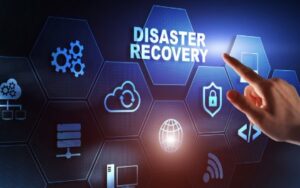 Power outages are an unfortunate reality of business life, and their consequences can be severe. From data loss to equipment damage, the impact can be far-reaching. However, there’s a simple, effective way to safeguard your business against these disruptions: a quality uninterruptible power supply (UPS). Let’s delve into why a UPS is more than just a backup solution — it’s a strategic investment that can protect your operations and enhance your bottom line.
Power outages are an unfortunate reality of business life, and their consequences can be severe. From data loss to equipment damage, the impact can be far-reaching. However, there’s a simple, effective way to safeguard your business against these disruptions: a quality uninterruptible power supply (UPS). Let’s delve into why a UPS is more than just a backup solution — it’s a strategic investment that can protect your operations and enhance your bottom line.
What is a UPS?
A UPS serves as a backup power source for your devices. When the main power fails, a UPS kicks in seamlessly, ensuring your equipment continues to run without interruption. UPS units come in three primary types — online, line-interactive, and standby — each with unique features designed to handle different levels of power stability.
Online UPS systems offer continuous power from an inverter, making them ideal for protecting sensitive equipment and ensuring a seamless transition during an outage. Meanwhile, line-interactive UPS systems provide automatic voltage regulation, which is perfect for areas with frequent voltage fluctuations. And finally, standby UPS systems are the most basic type, offering a simple switch-over to battery power when the main power goes out.
The benefits of a quality UPS for your business
Safeguarding your data, equipment, and productivity are just a few of the reasons why investing in a quality UPS system is crucial.
Data protection
With data being the lifeblood of any modern business, protecting it should be a top priority. A quality UPS system ensures that you never lose crucial information during an unexpected power cut. By providing uninterrupted power, a UPS allows you to save open files and complete data backups without the risk of corruption. This feature is especially crucial for businesses that handle sensitive customer data or rely on real-time data processing.
But while a UPS is a great start to protecting your data, it’s also essential to have a robust data backup and recovery plan in place. This way, in the event of a more significant disaster, your data is not only safe but also easily recoverable.
Equipment protection
Sensitive electronic equipment can be easily damaged by voltage surges and spikes, which often occur during power outages. A UPS system shields your equipment from these electrical anomalies, extending their lifespan and maintaining their performance.
Consider the potential costs of repairing or replacing damaged equipment. Add to that the cost of downtime and lost productivity, and you’ll see how a quality UPS system is a cost-effective investment for any business.
Productivity and efficiency
Power outages not only disrupt your business but also directly impact productivity. Imagine the hours lost as employees wait for power to return, or the revenue lost due to missed sales opportunities. A UPS system prevents such disruptions, keeping your business operational and employees working without interruption.
Moreover, a UPS also helps maintain efficiency by preventing equipment failures due to power fluctuations. This means fewer service calls and less downtime for maintenance and repairs, allowing you to focus on core business tasks instead.
UPS or generator? Weighing your options
When considering backup power solutions, business owners often weigh the choice between a UPS and a generator. While both serve the purpose of keeping your business operational during an outage, they have distinct differences.
A UPS offers instant, seamless power transfer, making it ideal for protecting sensitive electronics and ensuring immediate continuity. Generators, on the other hand, can provide power for longer durations but may take time to start, leaving a gap in coverage. Additionally, generators require regular maintenance and fuel, which can add to operational costs.
While generators might be suitable for larger businesses with more extensive power needs, a UPS is often the better choice for small businesses seeking a cost-effective, low-maintenance solution. Ultimately, the right choice depends on your specific business needs, budget, and the critical nature of the equipment you need to protect.
It’s best to be prepared
Power outages can strike at any time, and unfortunately, they are often unpredictable. But by investing in a quality UPS system, you can confidently keep your business running without interruption. Don’t wait until the next outage to realize the importance of backup power — make the smart choice now and safeguard your operations from the unexpected.
If you’re unsure which UPS system is right for your business, contact us and we’ll be happy to help you find a solution that meets your needs.

 Power outages are a constant threat for businesses of all sizes. Imagine the chaos that ensues when operations grind to a halt, computers crash, and valuable data is at risk. This nightmare scenario can be avoided with a simple yet crucial investment: a quality uninterruptible power supply (UPS). Let’s explore why a UPS is not just a safeguard, but a strategic necessity for any business seeking uninterrupted productivity.
Power outages are a constant threat for businesses of all sizes. Imagine the chaos that ensues when operations grind to a halt, computers crash, and valuable data is at risk. This nightmare scenario can be avoided with a simple yet crucial investment: a quality uninterruptible power supply (UPS). Let’s explore why a UPS is not just a safeguard, but a strategic necessity for any business seeking uninterrupted productivity. Every business owner dreads power outages. Imagine having a productive day, tasks in full swing, and then suddenly everything goes dark. Computers shut down, work is interrupted, and valuable data hangs by a thread. This scenario is every business’s nightmare, but surprisingly, many still overlook a simple yet effective solution — a quality uninterruptible power supply (UPS). It’s time to shed light on why a UPS is not just a luxury, but a necessity for anyone looking to keep their operations running smoothly.
Every business owner dreads power outages. Imagine having a productive day, tasks in full swing, and then suddenly everything goes dark. Computers shut down, work is interrupted, and valuable data hangs by a thread. This scenario is every business’s nightmare, but surprisingly, many still overlook a simple yet effective solution — a quality uninterruptible power supply (UPS). It’s time to shed light on why a UPS is not just a luxury, but a necessity for anyone looking to keep their operations running smoothly. Imagine this: a hurricane is on the horizon, and you’re scrambling to protect your business. Don’t get caught off guard! Here’s a straightforward guide to creating a hurricane disaster recovery plan that will safeguard your company, your employees, and your valuable data.
Imagine this: a hurricane is on the horizon, and you’re scrambling to protect your business. Don’t get caught off guard! Here’s a straightforward guide to creating a hurricane disaster recovery plan that will safeguard your company, your employees, and your valuable data. Feeling anxious about hurricane season? Don’t be! This easy-to-follow guide will walk you through the essential steps of creating a hurricane disaster recovery plan for your business. With ample preparation, you can weather any storm and keep your business afloat.
Feeling anxious about hurricane season? Don’t be! This easy-to-follow guide will walk you through the essential steps of creating a hurricane disaster recovery plan for your business. With ample preparation, you can weather any storm and keep your business afloat. Hurricanes are an unstoppable force of nature, but the damage they can cause to your business is something you can control with the right approach. By taking proactive steps and creating a comprehensive hurricane disaster recovery plan, you can keep your employees safe, minimize downtime, and ensure your business recovers quickly.
Hurricanes are an unstoppable force of nature, but the damage they can cause to your business is something you can control with the right approach. By taking proactive steps and creating a comprehensive hurricane disaster recovery plan, you can keep your employees safe, minimize downtime, and ensure your business recovers quickly. As businesses embrace digital transformation, the specter of disasters looms larger than ever. Cyberattacks, system failures, and natural disasters are no longer rare occurrences but rather everyday challenges that organizations must confront. However, amidst these challenges, numerous myths and misconceptions about disaster recovery persist.
As businesses embrace digital transformation, the specter of disasters looms larger than ever. Cyberattacks, system failures, and natural disasters are no longer rare occurrences but rather everyday challenges that organizations must confront. However, amidst these challenges, numerous myths and misconceptions about disaster recovery persist. Disasters come in various forms, from malicious cyberattacks to unexpected system failures to natural calamities. With these threats becoming increasingly common, businesses must navigate through a maze of myths and misconceptions surrounding disaster recovery. Here are the top six disaster recovery myths you should be aware of.
Disasters come in various forms, from malicious cyberattacks to unexpected system failures to natural calamities. With these threats becoming increasingly common, businesses must navigate through a maze of myths and misconceptions surrounding disaster recovery. Here are the top six disaster recovery myths you should be aware of. Cyberattacks, system failures, and natural disasters have become a common occurrence, and they’re becoming increasingly more disruptive as businesses continue to digitize their operations. Having a disaster recovery plan is the best defense against these risks, but a shocking number of businesses are misinformed about what it takes to effectively recover from a disaster. Here are six myths about disaster recovery that every business should know.
Cyberattacks, system failures, and natural disasters have become a common occurrence, and they’re becoming increasingly more disruptive as businesses continue to digitize their operations. Having a disaster recovery plan is the best defense against these risks, but a shocking number of businesses are misinformed about what it takes to effectively recover from a disaster. Here are six myths about disaster recovery that every business should know. A faltering VoIP system can spell disaster, leading to productivity dips, customer dissatisfaction, and financial losses. To fortify your business against such risks, consider implementing the following strategies.
A faltering VoIP system can spell disaster, leading to productivity dips, customer dissatisfaction, and financial losses. To fortify your business against such risks, consider implementing the following strategies. Voice over Internet Protocol (VoIP) phone systems provide businesses with a cost-effective and flexible way to make and receive phone calls, but they’re not immune to downtime. Anything from network failures to power outages can cause VoIP systems to shut down, which is why you need to minimize downtime through the following means.
Voice over Internet Protocol (VoIP) phone systems provide businesses with a cost-effective and flexible way to make and receive phone calls, but they’re not immune to downtime. Anything from network failures to power outages can cause VoIP systems to shut down, which is why you need to minimize downtime through the following means. Voice over Internet Protocol (VoIP) phone systems have become vital for business operations, so any downtime can have a significant impact on your organization. It’s therefore crucial to reduce the risk of VoIP system failure. Here are seven ways you can do so.
Voice over Internet Protocol (VoIP) phone systems have become vital for business operations, so any downtime can have a significant impact on your organization. It’s therefore crucial to reduce the risk of VoIP system failure. Here are seven ways you can do so.